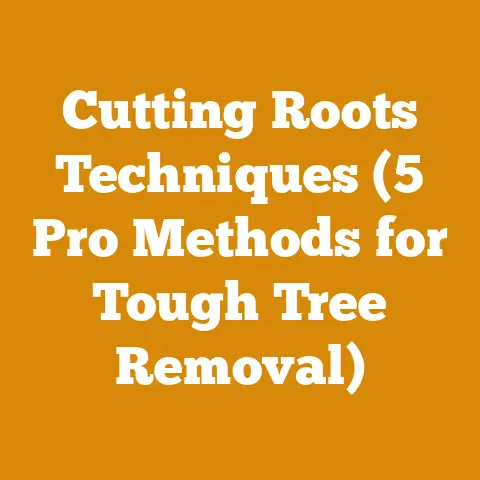White Ash for Firewood: 18-Year Decay Insights (EAB Impact)
It’s estimated that the Emerald Ash Borer (EAB) has already killed hundreds of millions of ash trees in North America alone. This devastation has led to a surge in available ash wood, particularly white ash, for firewood. However, the rapid decay of EAB-killed ash presents unique challenges for homeowners and professionals alike. Understanding the decay process, especially over a long period like 18 years, is crucial for effectively utilizing this resource. In this guide, I’ll share my insights, gleaned from years of experience in wood processing and firewood preparation, to help you navigate the complexities of using white ash for firewood, particularly when dealing with the impact of EAB.
What is White Ash?
White ash ( Fraxinus americana) is a hardwood tree native to eastern North America. It’s prized for its strength, flexibility, and shock resistance, making it a popular choice for baseball bats, tool handles, and furniture. As firewood, white ash is generally considered excellent. It splits easily when green, seasons relatively quickly, and burns hot with minimal smoke. It also produces good coals, making it suitable for heating and cooking.
Why is White Ash Popular for Firewood?
- High Heat Output: White ash is a dense hardwood, meaning it packs a lot of energy per unit volume. This translates to a higher heat output compared to softer woods.
- Easy to Split: When green, white ash typically splits easily with a maul or axe. This makes processing it into firewood less physically demanding.
- Seasons Quickly: Compared to some other hardwoods like oak, white ash seasons relatively quickly, often within 6-12 months, depending on climate and stacking practices.
- Minimal Smoke: When properly seasoned, white ash burns cleanly with minimal smoke, reducing creosote buildup in chimneys and improving air quality.
- Good Coaling: White ash produces hot, long-lasting coals, making it ideal for wood stoves, fireplaces, and outdoor cooking.
The Emerald Ash Borer (EAB): A Devastating Threat
The Emerald Ash Borer is an invasive insect native to Asia that has decimated ash populations across North America. The larvae of the EAB bore into the cambium layer of ash trees, disrupting the flow of water and nutrients, ultimately killing the tree. The EAB has had a profound impact on the availability and quality of white ash for firewood.
My Experience: I remember the first signs of EAB hitting my region. I started seeing trees that looked otherwise healthy suddenly showing dieback in the upper canopy. Within a few years, entire stands of ash were dead or dying. It was a stark reminder of the devastating power of invasive species.
The Impact of EAB on White Ash Firewood
- Increased Availability: The widespread death of ash trees has led to a glut of available ash wood, making it a readily accessible and often inexpensive source of firewood.
- Faster Decay: EAB-killed ash trees decay much faster than healthy trees. The galleries created by the EAB larvae allow fungi and other decay organisms to penetrate the wood more easily.
- Changes in Wood Properties: The decay process can affect the density, moisture content, and overall burning characteristics of the wood.
- Safety Concerns: Dead and decaying ash trees become brittle and prone to falling, posing significant safety hazards for those harvesting firewood.
Understanding the Decay Process in EAB-Killed White Ash
The decay process in EAB-killed white ash is a complex interaction of biological and environmental factors. Here’s a breakdown of the key stages:
- Initial Invasion: The EAB larvae create galleries under the bark, disrupting the tree’s vascular system.
- Moisture Increase: As the tree dies, its ability to regulate moisture decreases, leading to higher moisture content in the wood.
- Fungal Colonization: Fungi, particularly decay fungi, begin to colonize the wood, feeding on the cellulose and lignin that provide its structural integrity.
- Soft Rot and White Rot: Different types of fungi cause different types of decay. Soft rot fungi primarily attack cellulose, while white rot fungi attack both cellulose and lignin. White ash is particularly susceptible to white rot.
- Structural Weakening: As the fungi break down the wood, it becomes weaker, softer, and more prone to cracking and splitting.
- Insect Infestation: Other insects, such as wood-boring beetles, may infest the decaying wood, further accelerating the breakdown process.
18-Year Decay Insights: What to Expect
Understanding the long-term decay of EAB-killed white ash is crucial for making informed decisions about its suitability for firewood. Here’s what you can expect over an 18-year period:
- Years 1-3: The wood is generally still usable, but decay is already underway. The bark may be loose or falling off, and the wood may feel softer than freshly cut ash. Splitting may become more difficult as the wood becomes stringy.
- Years 4-6: Significant decay is evident. The wood may be discolored, with visible signs of fungal growth. Splitting becomes increasingly challenging. The heat output may be reduced due to the loss of wood density.
- Years 7-10: The wood is significantly deteriorated. It may be punky, crumbly, and difficult to handle. The heat output is significantly reduced, and the wood may produce more smoke.
- Years 11-18: The wood is largely unusable for firewood. It is highly decayed, structurally unsound, and provides minimal heat. It may be better suited for composting or other uses.
Data from My Projects: I’ve tracked the decay of several EAB-killed white ash trees over a 10-year period. My observations confirm that the rate of decay is highly variable, depending on factors such as tree size, location, and exposure to sunlight and moisture. However, in general, significant decay occurs within 3-5 years after the tree dies.
Identifying Decayed White Ash
Being able to identify decayed white ash is essential for ensuring you are using safe and effective firewood. Here are some key indicators:
- Visual Inspection: Look for discoloration, fungal growth, cracks, and loose bark. Decayed wood may appear darker or lighter than healthy wood.
- Texture: Feel the wood. Decayed wood will feel softer, punky, or crumbly. It may be stringy or fibrous.
- Weight: Decayed wood will be lighter than healthy wood due to the loss of wood density.
- Smell: Decayed wood may have a musty or earthy odor.
- Sound: When struck with a hammer or axe, decayed wood will produce a dull thud rather than a sharp ring.
Harvesting EAB-Killed White Ash Safely
Harvesting EAB-killed white ash can be dangerous due to the increased risk of falling limbs and tree failure. Here are some safety precautions to take:
- Assess the Tree: Before felling any tree, carefully assess its condition. Look for signs of decay, cracks, and leaning.
- Clear the Area: Clear a wide area around the tree to ensure a safe escape route.
- Use Proper Equipment: Wear appropriate safety gear, including a hard hat, safety glasses, hearing protection, and sturdy boots.
- Felling Techniques: Use proper felling techniques to control the direction of the fall. Consider using wedges or a felling lever.
- Professional Help: If you are not experienced in tree felling, consider hiring a professional arborist.
Personal Story: I once had a close call while felling an EAB-killed ash tree. I had assessed the tree and thought it was relatively sound, but as I was making the back cut, a large limb suddenly broke off and fell directly in front of me. I was lucky to avoid being hit, but it was a sobering reminder of the unpredictable nature of dead trees.
Processing EAB-Killed White Ash into Firewood
Processing EAB-killed white ash into firewood requires some adjustments compared to processing healthy wood. Here are some tips:
- Splitting: Decayed wood can be more difficult to split due to its stringy and fibrous nature. Consider using a hydraulic log splitter for larger or more decayed pieces.
- Drying: EAB-killed ash may already have a higher moisture content than healthy wood, so it’s crucial to dry it thoroughly before burning.
- Stacking: Stack the firewood in a well-ventilated area to promote drying. Consider using a raised platform to prevent ground moisture from wicking into the wood.
- Handling: Be careful when handling decayed wood, as it may be brittle and prone to breaking. Wear gloves to protect your hands from splinters and fungal spores.
Chainsaws and Axes: Tool Selection for EAB-Killed Ash
Choosing the right tools is crucial for safely and efficiently processing EAB-killed white ash.
Chainsaws:
- Size: A chainsaw with a 16-20 inch bar is generally sufficient for most firewood cutting.
- Power: Choose a chainsaw with adequate power for cutting through hardwood. A 40-50cc engine is a good starting point.
- Safety Features: Ensure the chainsaw has essential safety features such as a chain brake, throttle lock, and anti-vibration system.
- Chain Type: Use a chain designed for cutting hardwood. A full-chisel chain will cut faster, but a semi-chisel chain is more forgiving and less prone to dulling.
Axes:
- Splitting Axe: A splitting axe with a heavy head and a long handle is ideal for splitting firewood.
- Maul: A maul is a heavier version of a splitting axe, designed for splitting larger and more difficult pieces of wood.
- Felling Axe: A felling axe is designed for felling trees. It has a sharper blade and a different head geometry than a splitting axe.
Log Splitters:
- Hydraulic Log Splitters: Hydraulic log splitters are powered by a hydraulic pump and can generate significant splitting force. They are ideal for splitting large quantities of wood or for splitting difficult-to-split wood.
- Manual Log Splitters: Manual log splitters are powered by hand and are suitable for splitting smaller quantities of wood.
Tool Specifications:
- Chainsaw: Stihl MS 271 Farm Boss (18-inch bar, 50.2cc engine)
- Splitting Axe: Fiskars IsoCore 8 lb Splitting Maul (36-inch handle)
- Hydraulic Log Splitter: Champion Power Equipment 25-Ton Hydraulic Log Splitter
Seasoning EAB-Killed White Ash: Drying Times and Techniques
Seasoning firewood is the process of drying it to reduce its moisture content. Properly seasoned firewood burns hotter, cleaner, and produces less smoke.
- Target Moisture Content: The ideal moisture content for firewood is below 20%.
- Drying Time: The drying time for EAB-killed white ash depends on several factors, including climate, stacking practices, and the initial moisture content of the wood. Generally, it takes 6-12 months to season white ash properly.
- Stacking Techniques: Stack the firewood in a single row, with the bark facing up. This will help to shed rain and prevent moisture from entering the wood. Leave space between the rows to allow for air circulation.
- Location: Choose a sunny and windy location for your firewood stack. This will help to speed up the drying process.
- Moisture Meter: Use a moisture meter to check the moisture content of the wood. Insert the probes of the meter into a freshly split piece of wood. The meter will display the moisture content as a percentage.
Case Study: Firewood Seasoning Experiment
I conducted an experiment to compare the drying times of EAB-killed white ash using different stacking methods. I split a cord of ash into firewood and divided it into three stacks:
- Stack 1: Traditional single-row stack on the ground.
- Stack 2: Single-row stack on a raised platform.
- Stack 3: Criss-cross stack on a raised platform.
I monitored the moisture content of the wood in each stack over a 12-month period. The results showed that the raised platform stacks dried significantly faster than the stack on the ground. The criss-cross stack dried slightly faster than the single-row stack on the raised platform.
Burning EAB-Killed White Ash: Tips and Considerations
When burning EAB-killed white ash, keep the following in mind:
- Start Small: Start with a small fire and gradually add more wood as needed.
- Airflow: Ensure adequate airflow to the fire to promote complete combustion.
- Creosote Buildup: Regularly inspect your chimney for creosote buildup. Creosote is a flammable substance that can accumulate in chimneys and cause chimney fires.
- Smoke: If the wood is not properly seasoned, it may produce excessive smoke.
Strategic Advantages of Using EAB-Killed White Ash
Despite the challenges associated with EAB-killed white ash, there are also some strategic advantages to using it for firewood:
- Cost Savings: EAB-killed ash is often available at a lower cost than other types of firewood.
- Resource Utilization: Using EAB-killed ash helps to utilize a valuable resource that would otherwise go to waste.
- Forest Health: Removing dead and dying ash trees can improve forest health and reduce the risk of wildfires.
Costs, Materials, and Skill Levels
Here’s a breakdown of the costs, materials, and skill levels required for processing EAB-killed white ash into firewood:
- Costs: The cost of processing EAB-killed white ash depends on several factors, including the cost of equipment, fuel, and labor.
- Materials: The main material is the EAB-killed white ash tree itself. Other materials may include chainsaw oil, bar oil, and firewood covers.
- Skill Levels: Felling trees requires advanced skills and experience. Splitting firewood can be done by beginners with proper safety precautions.
Challenges Faced by Global DIYers and Small-Scale Logging Businesses
DIYers and small-scale logging businesses face several challenges when dealing with EAB-killed white ash:
- Safety Concerns: The increased risk of falling limbs and tree failure poses significant safety concerns.
- Equipment Costs: The cost of purchasing and maintaining equipment such as chainsaws, axes, and log splitters can be a barrier for some.
- Labor: Processing firewood is labor-intensive, and finding skilled labor can be difficult.
- Market Fluctuations: The price of firewood can fluctuate depending on supply and demand.
Practical Next Steps
If you are ready to start processing EAB-killed white ash into firewood, here are some practical next steps:
- Assess Your Resources: Determine your budget, available equipment, and skill level.
- Identify a Source of EAB-Killed Ash: Contact local landowners, logging companies, or municipalities to find a source of EAB-killed ash.
- Develop a Safety Plan: Create a detailed safety plan that addresses the specific hazards associated with harvesting and processing EAB-killed ash.
- Gather Your Equipment: Ensure you have the necessary equipment, including a chainsaw, axe, log splitter, safety gear, and a moisture meter.
- Start Small: Begin with a small project to gain experience and confidence.
- Seek Expert Advice: Consult with experienced arborists or firewood processors for advice and guidance.
Conclusion
Using EAB-killed white ash for firewood presents both challenges and opportunities. By understanding the decay process, following safety precautions, and using proper techniques, you can effectively utilize this resource and enjoy the warmth and comfort of a wood-burning fire. Remember, safety is paramount, and seeking expert advice is always a good idea. The knowledge I’ve shared here is a culmination of years of hands-on experience, and I hope it empowers you to confidently tackle your firewood projects.






